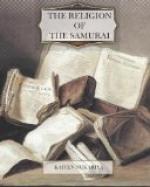Now let us say (a few words) to refute this doctrine also. If mind as well as external objects be unreal, who is it that knows they are so? Again, if there be nothing real in the universe, what is it that causes unreal objects to appear? We stand witness to the fact there is no one of the unreal things on earth that is not made to appear by something real. If there be no water of unchanging fluidity,[FN#373] how can there be the unreal and temporary forms of waves? If there be no unchanging mirror, bright and clean, how can there be various images, unreal and temporary, reflected in it? It is true in sooth that the dreaming mind as well as the things dreamed, as said above, are equally unreal, but does not that unreal dream necessarily presuppose the existence of some (real) sleepers?
[FN#373] The Absolute is compared with the ocean, and the phenomenal universe with the waves.
Now, if both mind and external objects, as declared above, be nothing at all, no- one can tell what it is that causes these unreal appearances. Therefore this doctrine, we know, simply serves to refute the erroneous theory held by those who are passionately attached to Dharma-laksana, but never clearly discloses spiritual Reality. So that Mahabheri-harakaparivarta-sutra[FN#374] says as follows: “All the sutras that teach the unreality of things belong to an imperfect doctrine (of the Buddha). Mahaprajnya-paramita-sutra[FN#375] says: “The doctrine of unreality is the first entrance-gate to Mahayanism.”
[FN#374] The book was translated into Chinese by Gunabhadra, A.D. 420-479.
[FN#375] This is not the direct quotation from the sutra translated by Hiuen Tsang. The words are found in Mahaprajnya-paramita-sutra, the commentary on the sutra by Nagarjuna.
When the above-mentioned four doctrines are compared with one another in the order of succession, each is more profound than the preceding. They are called the superficial, provided that the follower, learning them a short while, knows them by himself to be imperfect; (but) if he adheres to them as perfect, these same (doctrines) are called incomplete. They are (thus) said to be superficial and incomplete with regard to the follower.
CHAPTER III
The direct explanation of the real origin[FN#376]
5. The Ekayana Doctrine that Teaches the Ultimate Reality.
This doctrine teaches us that all sentient beings have the Real Spirit[FN#377] of Original Enlightenment (within themselves). From time immemorial it is unchanging and pure. It is eternally bright, and clear, and conscious. It is also named the Buddha-nature, or Tathagata-garbha.[FN#378] As it is, however, veiled by illusion from time without beginning, (sentient beings) are not conscious of its existence, and think that the nature within themselves




